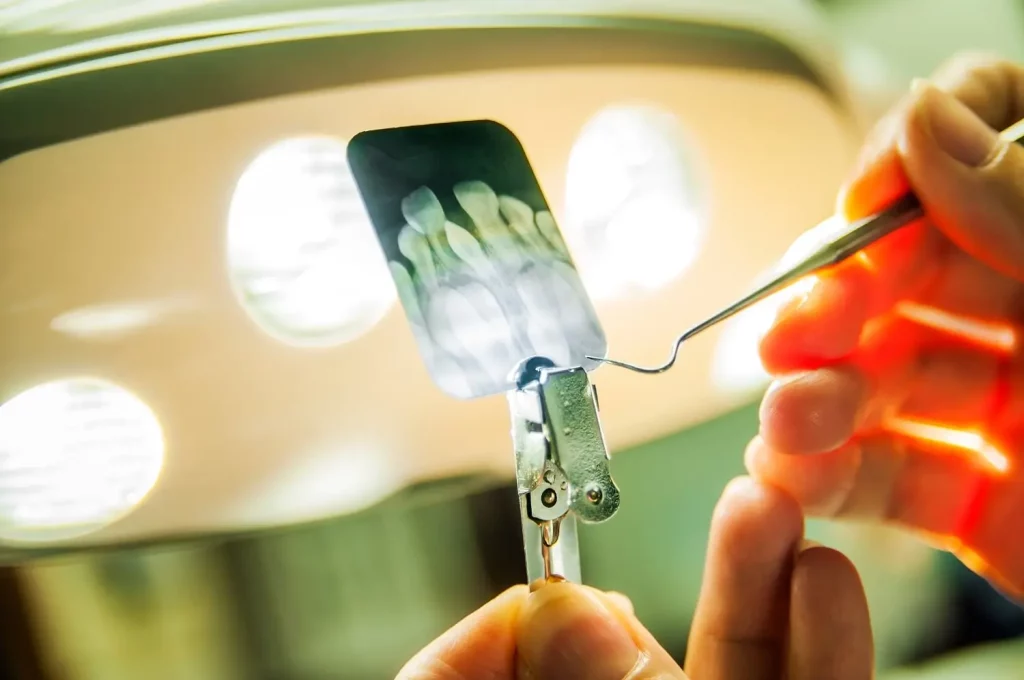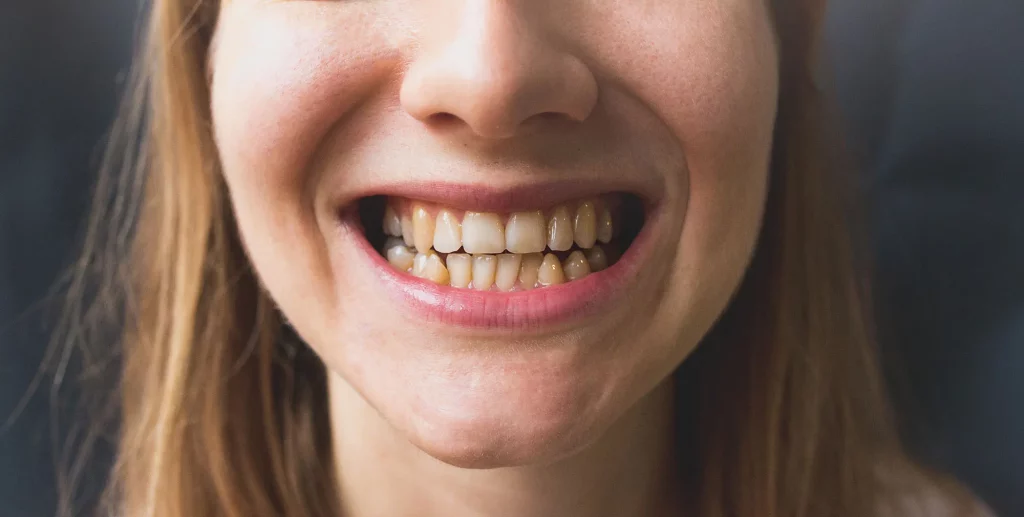Last Updated on: 12th August 2025, 09:40 am
What is dentoalveolar ankylosis(ankylosed tooth)?
Dentoalveolar ankylosis, also known as dental ankylosis, is an abnormality in which the root surface of the tooth is fused with the supporting bone.
To understand what happens in ankylosis, it is necessary to understand that:
- The roots of the teeth are covered in an outermost layer by a hard tissue, called root cement.
- The teeth are not directly attached to the bone but are separated from it by a structure called a periodontal ligament.
- The union between the bone and the tooth is achieved by the periodontal ligament fibers. These prevent teeth from moving out of place just by touching them or chewing.
- The periodontal ligament provides cushioning during movements, such as occlusion and chewing, becoming a kind of mattress that prevents direct friction between two hard components —bone and teeth— preventing future problems.
- Teeth are not totally immobile: The periodontal ligament allows for micro-movements during chewing.
When dentoalveolar ankylosis occurs, the periodontal ligament is totally or partially lost, giving rise to a strong union between the tooth and the bone. Thus, the jawbone is fused to the cementum or dentin, the substances that form the root of the tooth. This can prevent proper eruption and tooth movement.
Ankylosis occurs in one or several teeth. both in permanent and temporary dentition ( manifesting much more frequently. This anomaly tends to especially harm the mandibular molars.
What causes dentoalveolar ankylosis?
The most common factors that can cause dentoalveolar ankylosis:
- A congenital defect that causes a disturbance in ligament formation
- Periodontitis, although no genes causing this anomaly have yet been identified.
- Excessive force during chewing.
- Dental clenching or bruxism.
- Ametabolic abnormality in the bone, especially in the jaw.
- An infection that affects the teeth and/or the jaw bone.
- The constant pressure of the tongue on the teeth.
- A condition that affects the alveolar bone or periodontal ligament.
- Early loss or absence of the temporary teeth, creates a thick layer of bone that makes it difficult for the permanent tooth to erupt.
How to prevent dentoalveolar ankylosis?
As mentioned above, ankylosis has a variety of causes. Some of them are not preventable, such as birth defects. However, other causes can be prevented by taking the following precautions:
- Maintain strict oral hygiene: Brushing your teeth 3 times a day with fluoride toothpaste and flossing properly are key practices that aid in preventing tooth decay, infection, and tooth loss. Here’s how to floss properly.
- Avoid dentoalveolar trauma: Although it is known that during the first years of life, falls can be frequent, it is important that children develop the necessary motor skills to position their hands when falling and protect their faces.
- Consultation with the dentist after episodes of dental trauma: If the child suffers a blow or injury to the mouth or teeth, it is advisable to go to the dentist to determine a control routine, so that in the event that ankylosis develops, it can be diagnosed and treated early.
- Periodic dental check-ups: Perform dental checkups on children every 6 months, starting at age 2.
Signs of dentoalveolar ankylosis
Dentoalveolar ankylosis is an anomaly that does not cause pain. Therefore, it can only be identified by signs. The main signs are::
- Affected teeth look shorter or smaller: Usually, an ankylotic tooth is below the occlusal plane (shorter than its peers), as if it has not yet fully erupted.
- Lack of mobility: Teeth in their natural state have an almost imperceptible degree of mobility, but an ankylosed tooth totally lacks any kind of mobility.
- Retention of a temporary tooth: The primary tooth has not yet fallen out despite having exceeded the time it should have remained in the mouth.
- Dental impingement: Misalignment or crooked teeth of the affected jaw may be observed.
- Overeruption of the opposing tooth: Because teeth only stop erupting (emerging) when they meet the opposite tooth, the under-eruption of the tooth with ankylosis will produce an over-eruption of the opposite tooth.
What are the consequences of dental ankylosis?
When dental ankylosis is not discovered and treated in time, it can trigger associated problems, especially for the normal development of the jaws. Some of the ensuing problems are:
- If the tooth with ankylosis is a primary or temporary tooth, it can result in:
- Retention and possible loss of the permanent tooth inside the bone.
- The tooth is ectopic (in a position other than normal).
- The difference in diameter of the dental arch.
- The inclination of adjacent teeth.
- Extra space.
- The affected tooth does not come in contact with the teeth of the opposite arch, generating bite problems.
- Malocclusions, especially dental crowding and localized open bite.
- Alterations in chewing.
- Loss of the ankylosed or retained molar.
- Deformation of the facial skeletal structure.
- If the tooth does not reach an adequate position, there is a risk of developing caries and periodontal disease, since teeth in a bad position make oral hygiene difficult.
What are the types of dentoalveolar ankylosis?
In accordance with its degree of severity, dental ankylosis can be classified as follows:
- Mild ankylosis: The tooth is located a maximum of 2 millimeters above or below the level of their peers (infraocclusion).
- Moderate ankylosis: The tooth erupts but there is some contact with neighboring teeth.
- Severe ankylosis: In general, the tooth does not erupt, is hidden within the jawbone, or does not have sideways contact with neighboring teeth.
How is dentoalveolar ankylosis diagnosed?
Proper and early diagnosis is of vital importance to prescribe an opportune treatment that will prevent undesired consequences. For this diagnosis, the dentist will perform:
- A clinical evaluation: to observe and detect the obvious typical signs.
- A radiographic study: radiographs are essential in that they show the union between the bone and the surface of the dental root, as well as the absence of space where the periodontal ligament should be located.
What is the treatment for dentoalveolar ankylosis?
- The initial treatment focuses on conditions that will have negative consequences on facial growth, development, and tooth eruption. Timely intervention can prevent and control complications.
- Upon the condition every 6 months or at the frequency indicated by the dentist. Visits may involve clinical examination and taking X-rays to observe the evolution of the developing tooth.
- When an abnormality occurs in the temporary teeth (the most common), extraction of the ankylosed tooth is advised, along with posterior space management. This refers to the use of devices that prevent the side teeth from leaning or moving toward the area where the tooth was lost, reserving space for the final tooth to emerge.
- When ankylosis occurs in permanent teeth, the dentist may suggest several treatment options, depending on the case:
- Minor surgery to expose and reposition the emerging tooth with orthodontic treatment.
- If the ankylosis is very severe and the tooth must be extracted, the following is done:
- Close the space by moving the other teeth with orthodontic brackets.
- Perform an autotransplant, or extract a less visible tooth and position it in the space of the missing tooth.
- Insert an implant.
Conclusion
Dental ankylosis is a rare condition that alters the eruption of the teeth because it causes a direct and strong union between the tooth and the bone, as a consequence of the loss of the ligament that joins them. This condition, therefore, prevents the total or partial eruption of the teeth, causing various problems. Although the causes are not sufficiently clear, it is possible to prevent it by avoiding tooth loss, dental infections, and trauma. The success of the treatment for dental ankylosis is greater when started early.
It is recommended to take children to dental check-ups every 6 months to control dental eruption and detect anomalies in a timely manner. Currently, there are various treatments for ankylosis and the consequences derived from it, which include joint work between various specialties such as: pediatrics, orthodontics, oral surgery, and aesthetic oral rehabilitation.
Contact us
If you have any questions about this or other topics, you can contact us at Channel Island Family Dental as well as our Facebook page. We look forward to your visit and will make a timely diagnosis. Our dentists in Oxnard, Santa Paula, Ventura, Newbury Park, and Port Hueneme will be able to guide you towards the best treatment to take care of your health and return your best smile.
Bibliography
- Melo M, Alves LA. (Sep, 2011) Treatment of ankylosis of the mandibular first molar with orthodontic traction immediately after surgical luxation. Am J Orthod Dentofacial Orthop, 140:396-403.
- Suprabha BS, Pai SM. (May, 2006) Ankylosis of primary molar along with congenitally missing first permanent molar. J Indian Soc Pedod Prev Dent, 24: 35-7.
- Gondim J, Siebra JJ, Carvalho FM, Campelo R, Baratta AL, Aparecida EM. (May 2013) An Unusual Case of Severe Primary Molar Infraocclusion. J Dent Child, 80:88-91.
- Eşian, D., Bica, C. I., Stoica, O. E., Dako, T., Vlasa, A., Bud, E. S., Salcudean, D., & Beresescu, L. (Ago 8, 2022). Prevalence and Manifestations of Dental Ankylosis in Primary Molars Using Panoramic X-rays: A Cross-Sectional Study. Children (Basel, Switzerland), 9(8), 1188. https://www.mdpi.com/2227-9067/9/8/1188
- Bosio, J. A. (May 23, 2022). Navigating into the Dental Ankylosis World. https://education.aaoinfo.org/aaoinfo/sessions/12122/view
- Marek, I. (May 23, 2022). Central Incisor Ankylosis in Children & Adolescents: Extraction, Distraction or Autotransplantation? https://education.aaoinfo.org/aaoinfo/sessions/12107/view
















